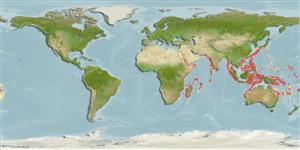>
Scombriformes (Mackerels) >
Centrolophidae (Medusafishes)
Etymology: Psenopsis: Greek, psenos, -e, -on = without hair + Greek, opsis = appearance (Ref. 45335).
Environment: milieu / climate zone / depth range / distribution range
Ecología
marino batidemersal; rango de profundidad 200 - 800 m (Ref. 4410). Deep-water
Indo-West Pacific: Mozambique Channel (22°S, 36°E), Andaman Sea and Molucca Sea (Ref 4410) and West Australian Basin (Ref. 54802).
Tamaño / Peso / Age
Maturity: Lm ? range ? - ? cm
Max length : 20.0 cm TL macho / no sexado; (Ref. 4410)
Short description
Claves de identificación | Morfología | Morfometría
Espinas dorsales (total) : 5 - 7; Radios blandos dorsales (total) : 26 - 29; Espinas anales: 2 - 3; Radios blandos anales: 25 - 28. Dark brownish blue to brown, tan laterally, darker area on shoulder near lateral line (Ref. 4410).
Found over sandy and muddy bottoms (Ref. 5213).
Life cycle and mating behavior
Maturities | Reproducción | Spawnings | Egg(s) | Fecundities | Larva
Haedrich, R.L., 1986. Stromateidae. p. 842-846. In M.M. Smith and P.C. Heemstra (eds.) Smiths' sea fishes. Springer-Verlag, Berlin. (Ref. 4410)
IUCN Red List Status (Ref. 130435)
Threat to humans
Harmless
Human uses
Herramientas
Special reports
Download XML
Fuentes de Internet
Estimates based on models
Preferred temperature (Ref.
123201): 8.4 - 15.7, mean 11.1 °C (based on 315 cells).
Phylogenetic diversity index (Ref.
82804): PD
50 = 0.5156 [Uniqueness, from 0.5 = low to 2.0 = high].
Bayesian length-weight: a=0.00891 (0.00406 - 0.01955), b=3.10 (2.91 - 3.29), in cm total length, based on LWR estimates for this (Sub)family-body shape (Ref.
93245).
Nivel trófico (Ref.
69278): 3.5 ±0.5 se; based on size and trophs of closest relatives
Resiliencia (Ref.
120179): Medio, población duplicada en un tiempo mínimo de 1.4-4.4 años (Assuming tmax>3).
Fishing Vulnerability (Ref.
59153): Low vulnerability (10 of 100).
